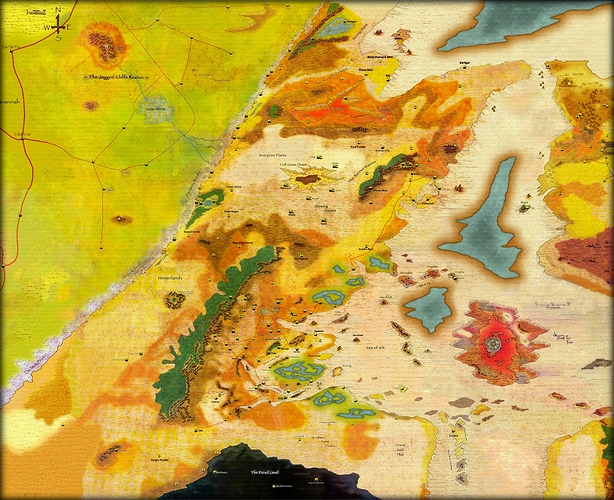Hi everyone. I’ve been following Dark Sun for a few years now ever since 4e. Even though I was never interested in it’s 2e counterpart one thing that always stood out to me from that time was the Cerulean Storm created at the end of the PP books. Though the means behind it have changed, I figured I’d want to share with you a map a friend & I created and how it impacts the world of Athas for feedback and perhaps to influence other DMs!
The Cerulean Storm in this case was not created via the PP. Rather, a fool-hearty attempt to breach the Elemental Chaos and bring forth water into Athas (perhaps by Keltis/Oronis). It succeeded, though birthed a violent and furious storm which not even the Dragon of Tyr can cease. This has however, proven some benefit, as the storm, and it’s lesser Tyr-Storms are mobile and occasionally moves over The Tablelands, bringing torrential downpours and raging thunderstorms of lightning and hail with them. This has resulted in formerly shallow basins of water along the Tablelands becoming filled with water whenever the storms pass through. But permanent habitation in the area is ill-advised due to the storms that sustain the water generally killing most residents who are there when they pass overhead.
Likewise, the main storm itself, being a force of raw, unrestrained Elemental power has breathed some life back into the Sea of Silt, hammering it with water so frequently and viciously that .neither Ul-Athra, or the Silt Tide spell of Keltis (depending on which story you want to use) can get rid of it. This has caused a resurgence of life in the former Sunrise Sea. However, at the cost of inviting in monsters of the Elemental Chaos such as Aboleths and feral Sahuagin more animalistic than their Toril counterparts.
The storm’s impacts have not all been negative however. One of the inland basins of water filled by the Storm’s power is north of the city-state of Draj. This has shifted the balance of power in The Tablelands, as suddenly Tectuktitlay, Sorcerer-King of Draj has more legitimacy for his religious cult in the eyes of the common people. Additionally the Temple of Elemental Rain in Draj has surged in popularity with the storms and the basins they’ve brought with them, becoming dominant among the Paraelemental Priests to rival Sun & Silt, and now leaving Magma the “weakest.” All this together has led to the “Great Water Wars” between Draj and it’s fellow city-states of Raam and Urik. Sorcerer-Kings Hamanu and Abalach-Re trying to destroy Tectuktitlay for his assertions of dominance, as he is the “weakest” Sorcerer-King. Tectuktitlay however learned at this point the power of “Cerulean Magic” - Defiling/Preserving the Tyr-Storms themselves and thus manipulating them when they pass overhead. The revelation of this magic having led him to victory against Urik and Raam’s armies where a grand sacrifice was held. A tenuous “truce” has been held since.
That’s not to say that Drajian politics and power within The Tablelands are the only things to be effected by this and I am quite open and eager to hearing suggestions! The map here unfortunately shows Ur-Draxa. Though as stated earlier, the Cerulean Storm in this homebrew is mobile over the general Sunrise Sea area. One can simply assume where it might be.
